Released in 1964, two
years after the Cuban missile crisis, Dr. Strangelove, Or: How I Learned to
Stop Worrying and Love the Bomb is a farcical nightmare dreamed during the
Ban-the-Bomb '60s. Today, of course, the Communist flag no longer waves over the
Kremlin, and they're closing up shop at the Strategic Air Command's underground
headquarters in Omaha. The push-button Armageddon imagined in Stanley Kubrick's
seventh feature seems unthinkable, even laughable.

Then again, with the thawing
of the Cold War comes the unsettling realization that what the New York
Times called an "oddly reassuring balance of terror" may begin to seem
preferable to a new world order in which every military dictatorship larger than
a launch pad seems to have The Bomb, and the Soviet nuclear arsenal is being
snatched up by eager bargain hunters. As Terminator 2: Judgment Day and
Wim Wenders' Until the End of the World suggest, the shadow of the
mushroom cloud still darkens our collective dreams. In a sense, Dr.
Strangelove is as timely as ever.
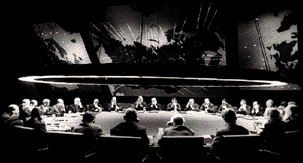
Peter George's Red Alert (1958)
provided the perfect springboard for a film about an accidental nuclear conflict.
Researched down to the last detail, the novel seemed ideal for Kubrick -- at 35
he already had a reputation as a painstaking perfectionist who shot every scene
as if it were an oil painting. The filmmaker soon realized that nothing could be
more absurd than a tale of two superpowers who, through a comedy of errors, blow
the world to smithereens. In a decisive move, Kubrick hired comic novelist Terry
Southern to co-author the screenplay. With George's aid, they transformed a taut
suspense yarn into what is perhaps the blackest comedy in movie history.

Even
though it is a pitiless lampoon of the establishment -- superhawks, effete
politicians, shifty-eyed diplomats and bumbling underlings alike -- Dr.
Strangelove is also a nail-biter of a Cold War thriller whose family tree
includes Fail Safe (1964), Colossus: The Forbin Project (1970) and
War Games (1983). It is also one of the ground-breaking films that ushered
in the new cinema of the '60s. Its architectonic perfection can be seen in the
visual geometrics of its three main locations (Burpelson Air Force Base, a B-52
named "Leper Colony," the War Room), whose chiaroscuro lighting echoes the mythic
look of Citizen Kane, in the use of up-angle shots that turn starkly-lit
faces into imposing monuments.

The casting, too, is inspired. George C. Scott
gobbles up the role of General "Buck" Turgidson, chomping his gum, slapping his
belly and carrying on like the turgid buck he is. And Peter Sellers is great fun
as the Adlai Stevensonian egghead, President Merkin Muffley, the heel-clicking
Group Captain Lionel Mandrake, and the technotronic monster who waits in the
shadows, Dr. Strangelove himself.
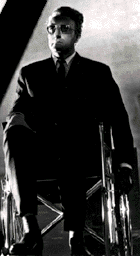 Viewed symbolically, Dr. Strangelove
is apocalyptic pornography about the strangest love of all, that of aging
powerbrokers for sexy weaponry. Film critic Gerald Mast has argued that "the
essential Kubrick theme is man's love affair with death," and nowhere in his body
of work does the filmmaker improvise on that theme with greater virtuosity, or
more delicious nastiness, than in Strangelove.
Viewed symbolically, Dr. Strangelove
is apocalyptic pornography about the strangest love of all, that of aging
powerbrokers for sexy weaponry. Film critic Gerald Mast has argued that "the
essential Kubrick theme is man's love affair with death," and nowhere in his body
of work does the filmmaker improvise on that theme with greater virtuosity, or
more delicious nastiness, than in Strangelove.
From the film's beginning
-- bombers copulating in mid-air to the strains of "Try a Little Tenderness" --
to its end -- an atomic gotterdammerung which unmistakably conjures multiple
orgasms -- we are treated to a parade of Freudian gags that confuse sex, death
and technology. In penetrating Mother Russia with his phallic B-52s, General Jack
D. Ripper (Sterling Hayden) reaffirms a manhood threatened by fluoridation, a
Communist plot (revealed to the General during lovemaking) to pollute "our
precious bodily fluids."
When Major T.J. "King" Kong (Slim Pickens) rides an
H-bomb into eternity, the missile suggests a penile prosthesis suitable for the
giant ape from whom the Major takes his name. And Strangelove, shriveled and
impotent, becomes fully erect only in a transport of rapture over the prospect of
global genocide and subsequent genetic experiments to be carried out on "a
nucleus of human specimens" -- at a Playboy ratio of 10 females to every male --
in a mine-shaft Fuhrer bunker.
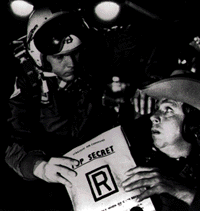
"I would like to make . . . a contemporary story
that really [gives] a feeling of the times, psychologically, sexually,
politically, personally," said Kubrick in 1960. In Dr. Strangelove, he
managed all that, and something more: the funniest joke ever told in the dark
about the end of the world.
-- MARK DERY
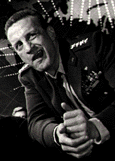
Credits
Produced and
Directed by: Stanley Kubrick
Screenplay by: Stanley Kubrick, Peter George,
Terry Southern
Based on the book Red Alert by: Peter George
Director of
Photography: Gilbert Taylor B.S.C.
Art Director: Peter Murton
Production
Designer: Ken Adam
Editor: Anthony Harvey
Music: Laurie
Johnson
Transfer
Dr. Strangelove was shot using in-camera
mattes with alternating aspect ratios, between 1.66:1 and 1.33:1. A new digital
film-to-tape transfer was created using a 35mm duplicate negative and 35mm
3-track magnetic master. This exclusive transfer was supervised by Stanley
Kubrick.


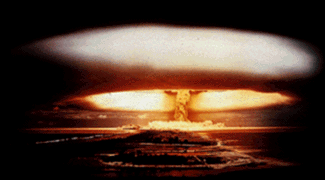





Viewed symbolically, Dr. Strangelove is apocalyptic pornography about the strangest love of all, that of aging powerbrokers for sexy weaponry. Film critic Gerald Mast has argued that "the essential Kubrick theme is man's love affair with death," and nowhere in his body of work does the filmmaker improvise on that theme with greater virtuosity, or more delicious nastiness, than in Strangelove.

